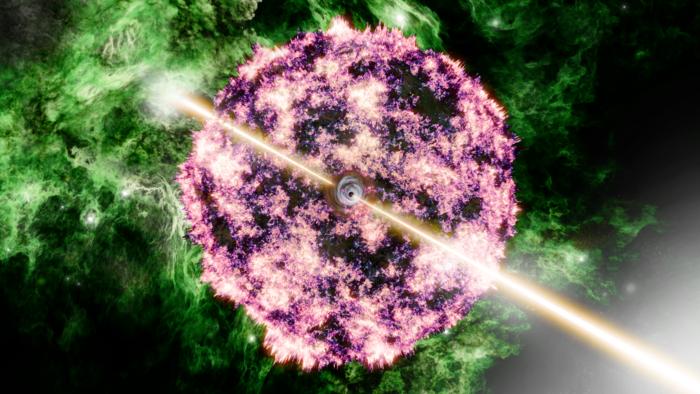Scientists find explanation for astonishingly bright signal coming from space
The ‘BOAT’ – or brightest of all time – appears to have come from the explosion of a massive star, but a new mystery has opened
Your support helps us to tell the story
This election is still a dead heat, according to most polls. In a fight with such wafer-thin margins, we need reporters on the ground talking to the people Trump and Harris are courting. Your support allows us to keep sending journalists to the story.
The Independent is trusted by 27 million Americans from across the entire political spectrum every month. Unlike many other quality news outlets, we choose not to lock you out of our reporting and analysis with paywalls. But quality journalism must still be paid for.
Help us keep bring these critical stories to light. Your support makes all the difference.
Scientists have found the source of the brightest gamma-ray burst ever detected.
The astonishingly bright signal – dubbed the ‘BOAT’, or brightest of all time – was found in October 2022. It was more than 10 times more powerful than any such gamma-ray burst or GRB detected before, and is thought to be a phenomenon that Earth sees only ever 10,000 years.
Now researchers say they have confirmed that it was the result of the collapse and then explosion of a massive star. Previously, researchers had been unable to confirm the source because the GRB itself was so bright, but they have now been able to do so using Nasa’s James Webb Space Telescope.

The supernova itself, the source of the blast, was remarkably normal.
“It’s not any brighter than previous supernovae,” said Peter Blanchard, from Northwestern University, who led the study. “It looks fairly normal in the context of other supernovae associated with less energetic GRBs.
“You might expect that the same collapsing star producing a very energetic and bright GRB would also produce a very energetic and bright supernova. But it turns out that’s not the case. We have this extremely luminous GRB, but a normal supernova.”
But while the new research solves one mystery, it also opens up a new one.
Scientists had believed that such an explosion would bring evidence of heavy elements such as platinum and gold – but none were found. That means that the mystery of where such heavy elements come from is unsolved, and remains one of the biggest mysteries of the universe.
“When we confirmed that the GRB was generated by the collapse of a massive star, that gave us the opportunity to test a hypothesis for how some of the heaviest elements in the universe are formed,” said Dr Blanchard. “We did not see signatures of these heavy elements, suggesting that extremely energetic GRBs like the BOAT do not produce these elements.
“That doesn’t mean that all GRBs do not produce them, but it’s a key piece of information as we continue to understand where these heavy elements come from. Future observations with JWST will determine if the BOAT’s ‘normal’ cousins produce these elements.”
The work is described in a new paper, ‘JWST detection of a supernova associated with GRB 221009A without an r-process signature’, published in Nature Astronomy.

Join our commenting forum
Join thought-provoking conversations, follow other Independent readers and see their replies
Comments